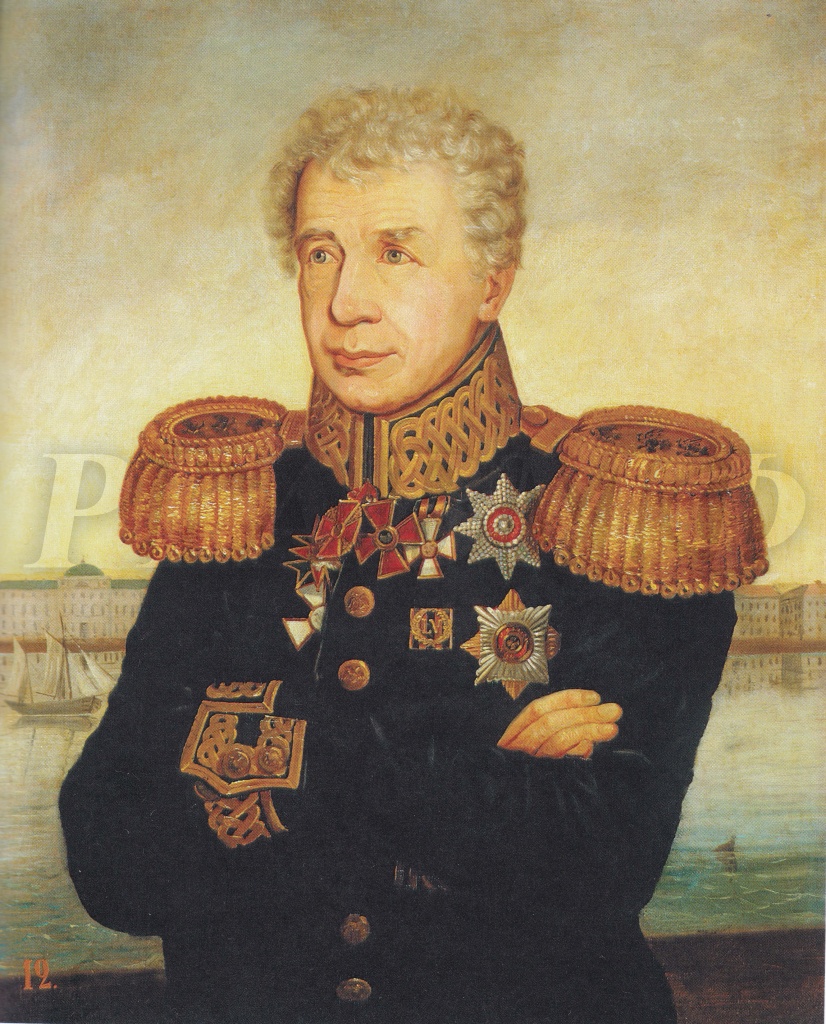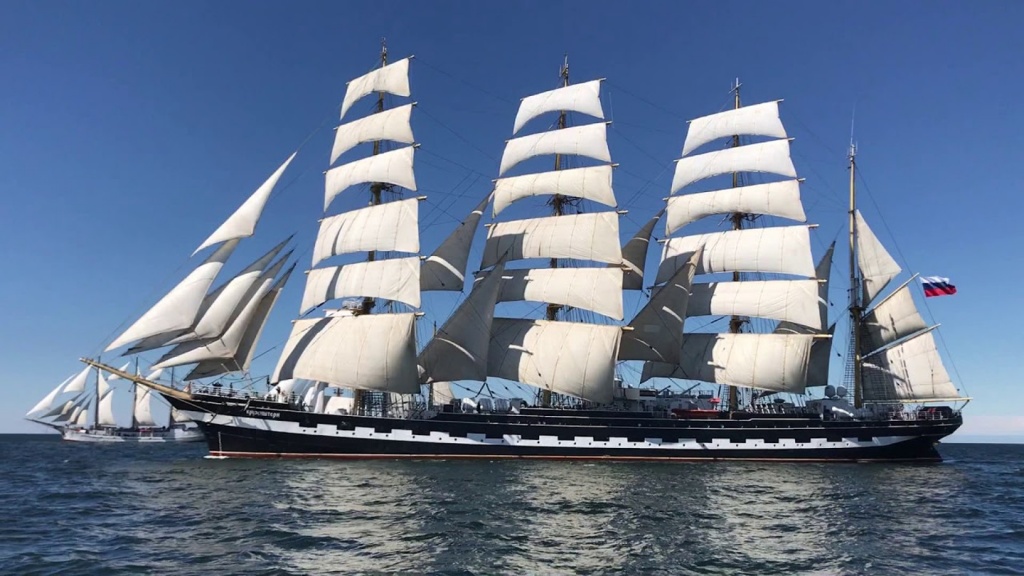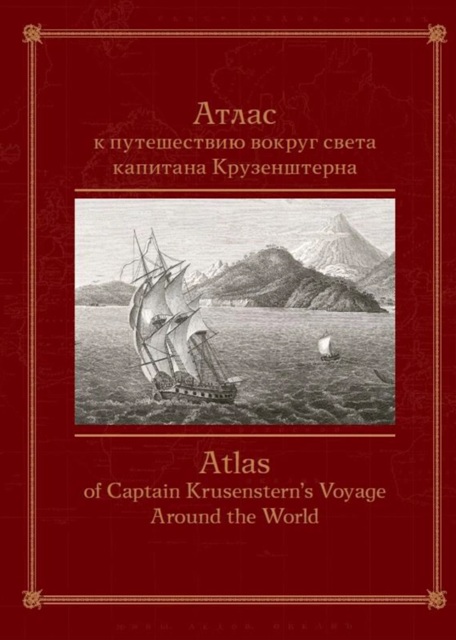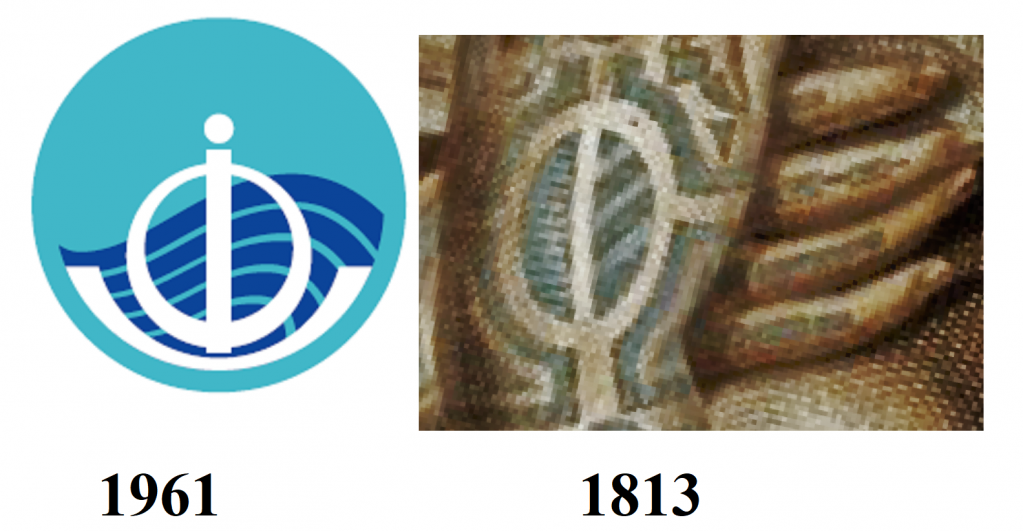
Krusenstern pioneered a path for Russia to become a strong maritime power
/ Главная / Russkiy Mir Foundation / Publications / Krusenstern pioneered a path for Russia to become a strong maritime powerKrusenstern pioneered a path for Russia to become a strong maritime power
Svetlana Smetanina
November 19 marks the 250th anniversary of the birth of Ivan Fyodorovich Krusenstern (Adam Johann von Krusenstern) who led the first Russian circumnavigation of the Earth. It was this voyage that enabled Russia to become one of the world's maritime powers and empowered Russian seafarers to discover Antarctica a few years later. Vitaly Sychev, a member of the RGS and UNESCO expert, tells about Ivan Krusenstern’s role in popularization of Russian science, as well as in establishment of the Russian Geographical Society that turns 175 these days.

Monument to Ivan Krusenstern in St. Petersburg. Photo credit: mylove.ru
– In his young days, Ivan Fyodorovich Krusenstern served a few years in the Royal Navy of Great Britain as he had been seconded there. Were such utilization tours a common practice for young naval officers back then?
– Yes, they were. And he was not the only one seconded to England. There were several officers, including Yuri Lisyansky, who would later lead the first Russian circumnavigation together with Krusenstern. I must say that Ivan Krusenstern joined the Naval Cadet Corps at the age of 14, although other boys studied there from the age of 9 or 10. He studied there for three years only, and then the Russian-Swedish war began. So he graduated ahead of schedule and was drafted into the Navy. There he was assigned to the Mstislav battleship under command of Grigory Ivanovich Mulovsky. By the way, it was Mulovsky who had written the first plan of the first Russian circumnavigation. And back in 1787 everything was ready for that voyage - even five different types of vessels were selected. But then the war with Turkey began, and those vessels left for the Mediterranean Sea.
Young Ivan Krusenstern learned about the circumnavigation from Grigory Mulovsky and this idea fired his imagination. During his utilization tour in Britain, Ivan Krusenstern took part in deep-sea voyages - he visited the Caribbean Sea, the American States. Various sources claim that while in the States Krusenstern virtually met George Washington. But those are more legends rather than the truth.
He also reached the Cape of Good Hope on British vessels. Many officers refused to sail further since the vessels were not very reliable. Nevertheless, Ivan Fyodorovich decided to continue the journey on one of the merchant vessels and thus ended up in China. Speaking English and German well, he learned a lot about the peculiarities of trade there. As a Russian citizen, he was inspired by the idea to make a sea route for Russian merchants so they could to travel to China for trade operations, which would be much more profitable than traveling by land across Siberia.
– Having returned to Russia, did he propose this plan to his command?
– Having returned from his overseas utilization tour, he submitted the circumnavigation project to the Naval department. But it was rejected. Krusenstern even thought to retire from military service. He was of Baltic German origin, and his family was not really wealthy, so he was looking for more profitable sources of income. But he was persuaded to stay. And as soon as Alexander I ascended to the throne, Krusenstern again submitted the circumnavigation project. At the same time, there were discussions about improvement of trade relations between Alaska, Russian America in California and the European part of Russia. And these two projects complemented one another.

Portrait of Admiral Ivan Krusenstern. Unknown artist. 2nd half of the 19th century. Photo credit: rgavmf.ru
It was decided to assign two vessels: they were to sail together to Hawaii and then take different routes. Krusenstern on his vessel was supposed to go to Japan, explore the Kuril Islands, Sakhalin. The second vessel was to sail to the coast of Russian America, then take a cargo of furs and head on to China. Both vessels were to reunite in Canton.
The Russian-American Trading Company seized on the idea of such an expedition and took care of the project financing. Yuri Lisyansky requested to join the Krusenstern expedition and went to Great Britain where he purchased two vessels – Nadezhda and Neva.
At the same time, the Russian government decided to kill two birds with one stone and send with the crew an envoy to Japan, which was then almost completely closed to foreigners. Thus, it was planned to start mutually beneficial trade cooperation between Japan and Russia. Nikolai Rezanov, who is well known from Juno and Avos, a Russian-language rock opera, was appointed to lead this mission.
– Did the Krusenstern expedition achieve all the goals set?
– If Ivan Fyodorovich knew what he would face on this voyage, he would have packed his belongings and returned to Revel. The trip was extremely challenging. First of all, the crews were very diverse, and immediately two groups were formed - one group included people who spoke mostly German, and the other was a group of Russians. Moreover, many of them happened to be aboard both vessels by accident. And it also affected the atmosphere there.
For another thing, there was a lot of tension between Krusenstern and Rezanov. Picture that: they lived in one cabin with area of about 6 square meters for nearly two years, and they did not talk to each other for the most of that time. They used to communicate either through notes or pass the information through their subordinates. Ivan Fyodorovich Krusenstern was appointed the expedition commander, and he was a captain-lieutenant. And Rezanov was promoted to the rank that corresponded to the rank of general. And this fact, of course, did not aid understanding.
But after they left Great Britain and reached the Canary Islands, Krusenstern got the most unexpected and unpleasant surprise. Rezanov suddenly come up with the Imperial order and claimed he had been entrusted to command this voyage.
But once the vessel left the port, the captain is in charge of it, and all the others shall follow his instructions and obey his decisions. And all those things put together polarized the expedition in no time, which aggravated the further situation and hampered contacts with local authorities, especially in Japan.

Modern Russian sailing ship named after Ivan Krusenstern. Photo credit: pwo.su
– Nevertheless, the expedition succeeded. After its completion, Krusenstern prepared several atlases with descriptions of what they had seen during the trip and finalized them for publishing.
– Yes, Kurlyandsev, an artist, was assigned to the expedition along with Rezanov. He was supposed to sketch all interesting things that he saw during various port calls. However, soon it became clear that he was a portrait painter, and other members of the expedition ridiculed his landscapes as they looked nothing like the actual ones. But the expedition also included Tilesius, a naturalist, and Horner, an astronomer. Langsdorf, another scientist, requested to join them in Copenhagen. So these three gentlemen turned out to be excellent drawing artists. Tilesius was the one who picked nuances of life really fast. His watercolors were taken as the basis for engravings included into the first Atlas of Krusenstern.
Langsdorf also drew a lot from life. He subsequently joined the Russian service and served as a Russian diplomat in Brazil, where he is revered as one of the greatest scientists of that time. He made many descriptions of both the nature and culture of Brazil.
The wonderful atlas of Krusenstern was published in 1812; and soon its newest edition will be published by the Paulsen Publishing House. The illustrations are fantastic. There are landscapes, birds, terrestrial animals, and marine organisms. Moreover, they were thoroughly drawn in fine line details and it is possible to determine the species and diversity of those animals.
– And you wrote the annotation to the new edition of the atlas.
– Ivan Fyodorovich Krusenstern was taken with the idea to describe the engravings included into his atlas. There are picturesque views of shores and landscapes captured by Tilesius and Horner. Tilesius also made detailed portraits of inhabitants of distant and exotic countries, sketched the first in history images of various animals, birds, fish, mollusks, and plants
We have collected the most interesting publications of the expedition members. Such publications were left by eleven people, namely by Krusenstern, Lisyansky, Rezanov, as well as Ratmanov, Levenshtern, Langsdorf, Tilesius, Shemelin, Korobitsyn, Hieromonk Gedeon, and Dr. Espenberg.
The engraving is on the right and its description is on the left of the broadside. In cooperation with scientists from Zoological Institute of the Russian Academy of Sciences, St. Petersburg University, and Hydrometeorological University, we added descriptions of birds, animals and marine organisms and placed them in the atlas edition. We demonstrated how they had been imagined back then, and how everything associated with each engraving looks now. Such way of presenting the information helps a person to be literally immersed into what is depicted in the atlas.

The Atlas of Krusenstern
Interestingly, the Krusenstern expedition brought some tattoo samples. Those samples were collected on the Marquesas Islands – bodies of the locals were literally covered with drawings and highly professional ones. Those magnificent drawings can also be seen in the atlas. By the way, many of those tattoos were later used in logos of companies and organizations.

The example of how a tattoo from the Atlas of Krusenstern is used as a logo
It was the first atlas of this kind and then it set the pattern for many years. We should be grateful to Krusenstern for this work.
– What do you think of Ivan Krusenstern’s contribution to science of that time?
– His expedition was the first circumnavigation by the representatives of the Russian state. Our country was the fifth or sixth state in the world whose seafarers sailed around the globe. And thus Russia became one the maritime powers.
Earlier we talked about Ivan de Traversay, the Minister of the Navy, and about the discovery of Antarctica. Krusenstern was the one who laid the foundation for that. He pioneered the path that enabled Russia to become a great maritime power equal to Great Britain just 15 years later.
For another thing, he published works about his voyages in foreign languages abroad. This is what our scientists lacked in the past and still do. His atlas was published in German in 1812. Then its translation from German into English was published - though of rather poor quality. The problem was that earlier the Langsdorf's book had been published in English. And for some reason the translator decided to translate only the part that had not been in the Langsdorf's book, not the entire book by Krusenstern. Therefore, the book by Krusenstern in English must be read together with the book by Langsdorf.
Books by Ivan Krusenstern in Russian and German were literally the reference books for all seafarers of the first half of the 19th century.
Magnificent maps were made as a result of the Krusenstern expedition. It is of little wonder as Krusenstern’s midshipman was Bellingshausen who was also a prominent cartographer. He plotted maps of the Kuril Islands and Sakhalin - these maps were the first precise ones that seafarers could use. Back then, the British and Danes were famous for their maps. And suddenly maps came from Russia and they were more precise than even the maps by the most renowned seafarers of that time!

Vitaly Sychev in the library of the Russian Geographical Society with the travel atlas of Ivan Krusenstern
Then Europe and the world heard about our expeditions. Before that, there was very little information about Russia's success in maritime affairs available in foreign languages. Ivan Fyodorovich sent the relevant information to geographical societies in Paris and London. Russian seafarers enjoyed immense authority, and the credit for that goes to Ivan Krusenstern.
While heading the Naval Cadet Corps, he trained naval officers at the highest level, having introduced the scientific basis for teaching. It was on his watch when the officer class was established, which became the foundation for the Naval Academy later on.
And finally, Ivan Fyodorovich contributed to establishment of the Russian Geographical Society in 1845. The Parisian one was founded in 1821, while the Berlin and the London Geographical Societies were established in 1828 and in 1830, respectively. Krusenstern was an honorary member of the London Geographical Society, and he was well-regarded by those circles. Thanks to his publications and membership in foreign scientific societies, the Russian authorities recognized that establishment of the Russian Geographical Society in Russia was important to promote scientific knowledge. Though, Krusenstern was not able to attend the first meeting of the Russian Geographical Society. He suffered a stroke on his way from St. Petersburg. It happened not far from Narva. He was lying motionless for two months. Those events happened 175 years ago - it was in August 1845 that the Russian Geographical Society was established, and its constitutive meeting was held in October. Nevertheless, the portrait of Ivan Fyodorovich Krusenstern has the rightful place among the portraits of the founders of the Russian Geographical Society.
New publications

 Mikhail Kalatozov, a director who transformed the world of cinematography in many ways, was born 120 years ago. He was a Soviet film official and a propagandist. Above all, he was capable of producing movies that struck viewers with their power and poetic language.
Mikhail Kalatozov, a director who transformed the world of cinematography in many ways, was born 120 years ago. He was a Soviet film official and a propagandist. Above all, he was capable of producing movies that struck viewers with their power and poetic language.  Ukrainian authorities have launched a persecution campaign against the canonical Ukrainian Orthodox Church (UOC), the biggest one in the country's modern history. Over the past year, state sanctions were imposed on clergy representatives, searches were conducted in churches, clergymen were arrested, criminal cases were initiated, the activity of the UOC was banned in various regions of the country, and monasteries and churches were seized.
Ukrainian authorities have launched a persecution campaign against the canonical Ukrainian Orthodox Church (UOC), the biggest one in the country's modern history. Over the past year, state sanctions were imposed on clergy representatives, searches were conducted in churches, clergymen were arrested, criminal cases were initiated, the activity of the UOC was banned in various regions of the country, and monasteries and churches were seized.  When Nektary Kotlyaroff, a fourth-generation Russian Australian and founder of the Russian Orthodox Choir in Sydney, first visited Russia, the first person he spoke to was a cab driver at the airport. Having heard that Nektariy's ancestors left Russia more than 100 years ago, the driver was astonished, "How come you haven't forgotten the Russian language?" Nektary Kotlyaroff repeated his answer in an interview with the Russkiy Mir. His affinity to the Orthodox Church (many of his ancestors and relatives were priests) and the traditions of a large Russian family brought from Russia helped him to preserve the Russian language.
When Nektary Kotlyaroff, a fourth-generation Russian Australian and founder of the Russian Orthodox Choir in Sydney, first visited Russia, the first person he spoke to was a cab driver at the airport. Having heard that Nektariy's ancestors left Russia more than 100 years ago, the driver was astonished, "How come you haven't forgotten the Russian language?" Nektary Kotlyaroff repeated his answer in an interview with the Russkiy Mir. His affinity to the Orthodox Church (many of his ancestors and relatives were priests) and the traditions of a large Russian family brought from Russia helped him to preserve the Russian language.

 The leaders of the Friends of the Great Russia cultural association (Amici Della Grande Russia) in Italy believe that the Western policy of abolishing Russian culture in Europe has finally failed. Furthermore, it was doomed to failure from the beginning.
The leaders of the Friends of the Great Russia cultural association (Amici Della Grande Russia) in Italy believe that the Western policy of abolishing Russian culture in Europe has finally failed. Furthermore, it was doomed to failure from the beginning.  Name of Vladimir Nemirovich-Danchenko is inscribed in the history of Russian theater along with Konstantin Stanislavski, the other founding father of the Moscow Art Theater. Nevertheless, Mr. Nemirovich-Danchenko was a renowned writer, playwright, and theater teacher even before their famous meeting in the Slavic Bazaar restaurant. Furthermore, it was Mr. Nemirovich-Danchenko who came up with the idea of establishing a new "people's" theater believing that the theater could become a "department of public education."
Name of Vladimir Nemirovich-Danchenko is inscribed in the history of Russian theater along with Konstantin Stanislavski, the other founding father of the Moscow Art Theater. Nevertheless, Mr. Nemirovich-Danchenko was a renowned writer, playwright, and theater teacher even before their famous meeting in the Slavic Bazaar restaurant. Furthermore, it was Mr. Nemirovich-Danchenko who came up with the idea of establishing a new "people's" theater believing that the theater could become a "department of public education."  "Russia is a thing of which the intellect cannot conceive..." by Fyodor Tyutchev are famous among Russians at least. December marks the 220th anniversary of the poet's birth. Yet, he never considered poetry to be his life's mission and was preoccupied with matters of a global scale. Mr.Tyutchev fought his war focusing on relations between Russia and the West, the origins of mutual misunderstanding, and the origins of Russophobia. When you read his works today, it feels as though he saw things coming in a crystal ball...
"Russia is a thing of which the intellect cannot conceive..." by Fyodor Tyutchev are famous among Russians at least. December marks the 220th anniversary of the poet's birth. Yet, he never considered poetry to be his life's mission and was preoccupied with matters of a global scale. Mr.Tyutchev fought his war focusing on relations between Russia and the West, the origins of mutual misunderstanding, and the origins of Russophobia. When you read his works today, it feels as though he saw things coming in a crystal ball...